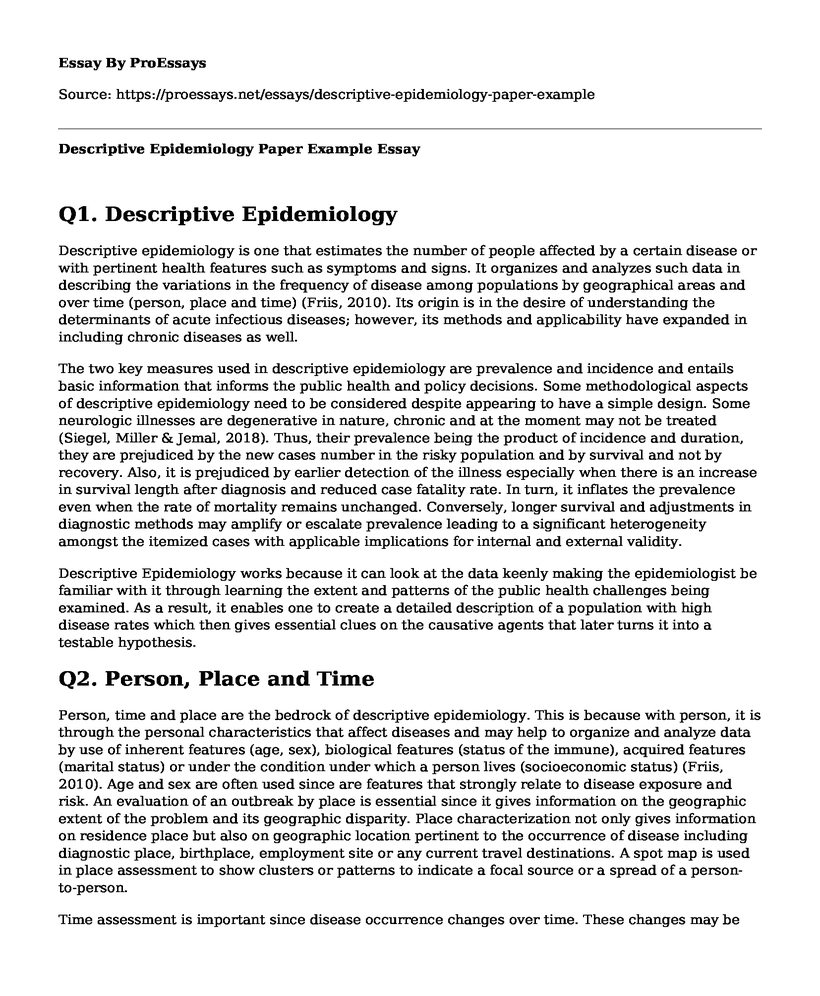Q1. Descriptive Epidemiology
Descriptive epidemiology is one that estimates the number of people affected by a certain disease or with pertinent health features such as symptoms and signs. It organizes and analyzes such data in describing the variations in the frequency of disease among populations by geographical areas and over time (person, place and time) (Friis, 2010). Its origin is in the desire of understanding the determinants of acute infectious diseases; however, its methods and applicability have expanded in including chronic diseases as well.
The two key measures used in descriptive epidemiology are prevalence and incidence and entails basic information that informs the public health and policy decisions. Some methodological aspects of descriptive epidemiology need to be considered despite appearing to have a simple design. Some neurologic illnesses are degenerative in nature, chronic and at the moment may not be treated (Siegel, Miller & Jemal, 2018). Thus, their prevalence being the product of incidence and duration, they are prejudiced by the new cases number in the risky population and by survival and not by recovery. Also, it is prejudiced by earlier detection of the illness especially when there is an increase in survival length after diagnosis and reduced case fatality rate. In turn, it inflates the prevalence even when the rate of mortality remains unchanged. Conversely, longer survival and adjustments in diagnostic methods may amplify or escalate prevalence leading to a significant heterogeneity amongst the itemized cases with applicable implications for internal and external validity.
Descriptive Epidemiology works because it can look at the data keenly making the epidemiologist be familiar with it through learning the extent and patterns of the public health challenges being examined. As a result, it enables one to create a detailed description of a population with high disease rates which then gives essential clues on the causative agents that later turns it into a testable hypothesis.
Q2. Person, Place and Time
Person, time and place are the bedrock of descriptive epidemiology. This is because with person, it is through the personal characteristics that affect diseases and may help to organize and analyze data by use of inherent features (age, sex), biological features (status of the immune), acquired features (marital status) or under the condition under which a person lives (socioeconomic status) (Friis, 2010). Age and sex are often used since are features that strongly relate to disease exposure and risk. An evaluation of an outbreak by place is essential since it gives information on the geographic extent of the problem and its geographic disparity. Place characterization not only gives information on residence place but also on geographic location pertinent to the occurrence of disease including diagnostic place, birthplace, employment site or any current travel destinations. A spot map is used in place assessment to show clusters or patterns to indicate a focal source or a spread of a person-to-person.
Time assessment is important since disease occurrence changes over time. These changes may be regularly or may be unpredictable. When a disease occurs regularly, health officials can foresee its occurrence and this can enable investigator put into practice its control and prevention measures (Siegel, Miller & Jemal, 2018). If the disease is sporadic, the investigator can carry out research in identifying the causes and spread modes which will then help in developing appropriately targeted actions of controlling and preventing further occurrence of the disease. Significantly, time assessment is essential for monitoring the occurrence of diseases in society and can help to assess the differences made in public health interventions. In descriptive epidemiology, there are no tests like lab tests since it is hard to predicate some information like characteristics of a person, the onset of a disease, and geographic location without meeting them in person.
References
Friis, R. H. (2010). Epidemiology 101. Jones & Bartlett Learning: Burlington, Massachusetts. ISBN 978-0-7637-5443-3)
Siegel, R. L., Miller, K. D., & Jemal, A. (2018). Descriptive Epidemiology. The American Cancer Society's Principles of Oncology: Prevention to Survivorship, 1-14.
Cite this page
Descriptive Epidemiology Paper Example. (2022, Nov 20). Retrieved from https://proessays.net/essays/descriptive-epidemiology-paper-example
If you are the original author of this essay and no longer wish to have it published on the ProEssays website, please click below to request its removal:
- Term Paper Example on Public Health: Orem's Self-care Model for Patients with Diabetes
- Research Paper Example on Saddleback Memorial Medical Centre
- Essay Sample on Lean Process Improvement at Cleveland Clinic
- Essay Sample on Nursing: From Submissive to Art & Science
- Essay Sample on Covid-19: Alarming Global Spread & Healthcare Industry at Risk
- Nursing: Caring for Optimal Health in Society - Essay Sample
- Essay Sample on Live Longer, Age Well: Essential for Sustainable Quality of Life







